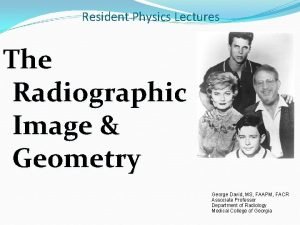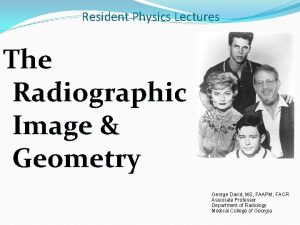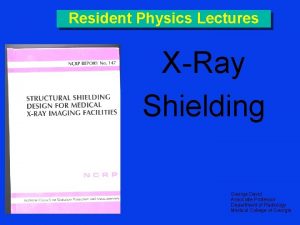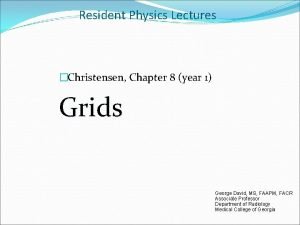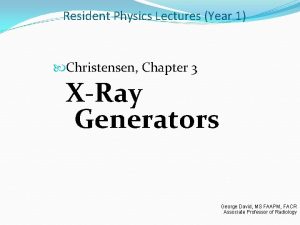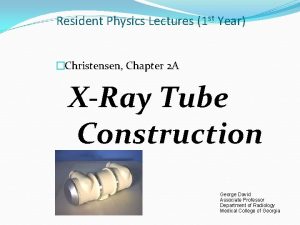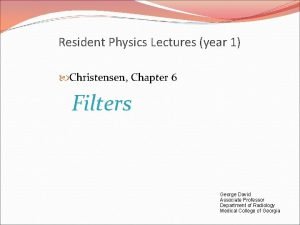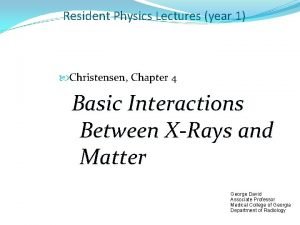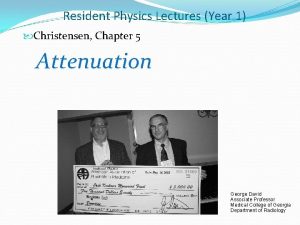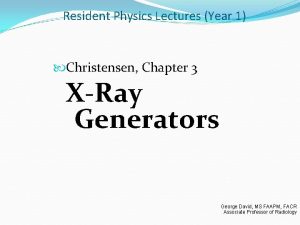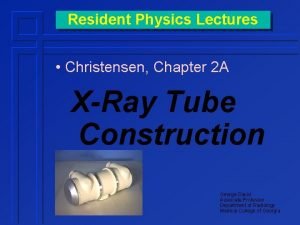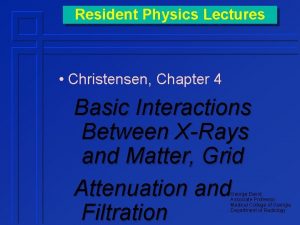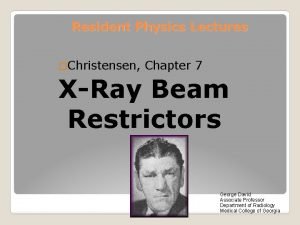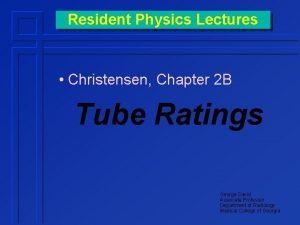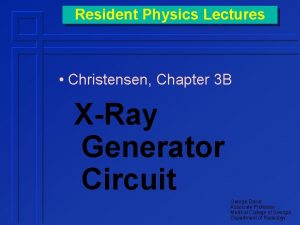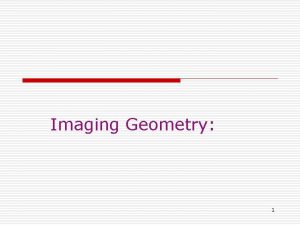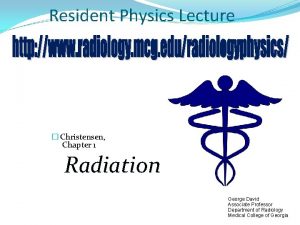Resident Physics Lectures Fluoroscopic Imaging year 1 George




























- Slides: 28

Resident Physics Lectures Fluoroscopic Imaging (year 1) George David Associate Professor of Radiology Medical College of Georgia

Early Fluoroscopy �Radiologist directly viewed fluorescent screen �screen covered with lead glass for protection �Low light levels � 10 -30 minute dark adaptation required by wearing red goggles

Human eye light receptors �rods (scotopic vision) � respond to very low light levels � night vision � peripheral vision � poor visual acuity � poor gray shade detection �cones (photopic vision) � high direct vision acuity � blind at low illumination levels

Image Intensifiers �evacuated glass envelope �vacuum tube

Image Intensifier x-rays ==> light �Input �X-rays �Output �Small viewing screen

Image Intensifier Components �input phosphor �x-rays to light �photocathode �light to electrons �electrostatic focusing lens �steer those electrons �accelerating anode �speed up those electrons �output phosphor �electrons to light

Input Phosphor x-rays ==> light �Cesium iodide (Cs. I) � Cs. I crystal needles perpendicular to substrate � minimizes lateral light diffusion or scattering � improves resolution �typical image tube resolution � 3 - 5 line pairs / mm

Input Phosphor �K-Edge of phosphors ¨ CS ==> (36 ke. V) ¨ I ==> 33. 2 ke. V ¨ well suited to average fluoro beam energy § 30 to 40 ke. V �absorbs ~ 2/3 of incident beam absorption energy

Photocathode light photons ==> electrons �attached to input phosphor �minimizes light diffusion �Photo-emissive metal �light causes emission of photoelectrons �# photoelectrons emitted proportional to incident light from input phosphor

Electrostatic Focusing Lens �Several electrodes plated to inside glass envelope lenses �+ voltage applied to electrodes � voltages determine magnification mode �focuses each point of input phosphor to a point on output phosphor � inverts & reverses image � Side-side � Top=bottom � Black-white + + + - - +

Accelerating Anode �in neck of image tube �+ 25 - 35 k. V charge �accelerates electrons �faster electrons produce more light when they strike output phosphor

Output Phosphor �Small viewable fluorescent Output screen Phosphor � 0. 5 - 1 inch diameter electrons ==> light �converts electron’s kinetic energy to light �~ 50 fold increase in # light photons over input phosphor

Output Phosphor �thin aluminum layer on back of output phosphor �prevents screen’s light from re-entering tube & reaching input phosphor Output Phosphor X - Aluminum

Output phosphor viewing �direct �uses lenses & mirrors �television �high quality closed circuit television chain

Image Tube Parameters �Brightness Gain �ratio of II brightness to a “standard” screen �Conversion Factor �light output per radiation rate input �Deterioration over time � 10% decline in brightness / year typical �must increase patient exposure to get same light intensity

II Gain (Intensification Factor) Output phosphor brightness -------------------“standard” screen brightness �typically ~ 10, 000

II Gain (Intensification Factor) �Brightness gain = minification gain X flux gain �Minification gain � making image smaller also makes it brighter �Flux gain � acceleration of electrons toward output phosphor Electrons +

Minification 12” mag mode 9” mag mode �Minification gain Area of (effective) input phosphor --------------------Area of output phosphor Smaller image Larger image Less magnification More minification Less minification Larger gain Smaller gain

Minification Gain �image brighter because output screen smaller than input screen �changes with magnification mode (9”, 6”, etc) �changes by about 2 X for each mag mode � typically 81 for 9” mode (output phosphor about 1” diam) � 36 for 6” mode � 16 for 4” mode Highest magnification Lowest Minification gain Lowest magnification Highest Minification gain 12” 9” 6”

Auto-Brightness �Generator senses image brightness and modulates beam intensity to hold brightness constant Lowest magnification Highest Minification gain Lowest dose 12” Highest magnification Lowest Minification gain Highest dose 9” 6”

Flux Gain �Caused by high + voltage of anode � acceleration of electrons in tube �Does not change with magnification mode �typical value ~ 50

Contrast �Ratio of brightness at center of image with & without blocking center �typically 10: 1 to 20: 1 Light Meter Lead

Image Tube Contrast �degrades over time �depends on Light Meter �collimation �tube properties � input phosphor photon absorption � output phosphor electron absorption � light backscatter from output phosphor to input phosphor Lead

Other II Characteristics �Lag �persistence of illumination after irradiation �insignificant for modern tubes �Distortion �Image intensifier has rounded bottom �Electron steering better in center than in periphery � unequal magnification �straight lines appear bent � pincushion effect

Vignetting �loss of brightness in image periphery �caused by � periphery displayed over larger area of input screen � decreases brightness � poorer periphery focus

Multi-Field Image Tubes �Dual, 3 X, 4 X field sizes common �Image focused by adjusting voltage on focusing electrodes (electronic lenses) �By law, collimators must cone in during mag operation � X-ray field should match imaged field 9“ 6”

Magnification �Advantages � Magnifies anatomy � improves spatial resolution �Disadvantages � smaller field of view � increased radiation intensity (but less tissue exposed) � decreased minification gain 9“ 6”

Digital Fluoroscopic Receptors Flat Panel Digital Technology Now used for angiography / cardiology and some portable Carms No spatial distortion
 Ota resident lectures
Ota resident lectures Ota core curriculum
Ota core curriculum Frc driver station mac
Frc driver station mac Frcr physics lectures
Frcr physics lectures Frcr physics lectures
Frcr physics lectures George washington x king george iii
George washington x king george iii George washington vs king george iii venn diagram
George washington vs king george iii venn diagram What year did george washington attacks ft necessity
What year did george washington attacks ft necessity Year 6 leavers poem for teacher
Year 6 leavers poem for teacher Resident set management
Resident set management Resident retention
Resident retention Resident set management
Resident set management What is a us tin number
What is a us tin number Biostats step 3
Biostats step 3 Resident lifecycle
Resident lifecycle Chapter 2 foundations of resident care
Chapter 2 foundations of resident care Attending vs resident
Attending vs resident Examples of misappropriation of resident property
Examples of misappropriation of resident property A helpful way for an na to respond to hallucinations is to
A helpful way for an na to respond to hallucinations is to Cna chapter 10 positioning transfers and ambulation
Cna chapter 10 positioning transfers and ambulation Partially resident textures
Partially resident textures Acgme resident survey
Acgme resident survey Employment of non-resident aliens in the philippines
Employment of non-resident aliens in the philippines Telephone 911
Telephone 911 Conflict resolution customer service
Conflict resolution customer service Define resident flora
Define resident flora Resident subnet
Resident subnet Resident assessment instrument definition
Resident assessment instrument definition Tarrytown chief resident conference
Tarrytown chief resident conference





























